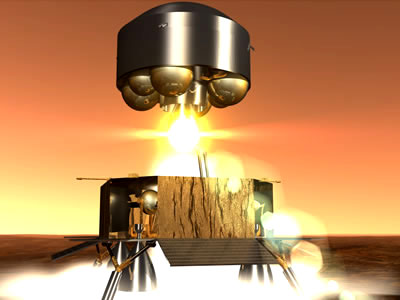Anybody with a modicum of intellectual curiosity is looking forward to the NASA/ESA Mars Sample Return Mission. NASA’s Perseverance rover is busily collecting and caching samples for eventual return to Earth. While the technical and engineering challenges in getting those samples into scientists’ hands here on Earth are formidable, budgeting and funding might be the mission’s biggest headaches.
Budgetary wrangling between NASA and Congress is nothing new. During its development, the James Webb Space Telescope faced potential cancellation as lawmakers balked at its growing expense. Even the Apollo Program had its budget cut. But this time, it’s NASA itself that is curtailing its budget. NASA announced that it’s taking the unusual step of cutting its budget for the Mars Sample Return Mission.
The MSR mission has struggled with ballooning costs. While initially estimated at $4 billion US, the expected cost has inflated to nearly $11 billion US. Compare that to the Perseverance mission, which cost about $2.4 billion to build and launch. Obviously, the MSR mission is more complicated, but a $7 billion price increase can be hard to rationalize, no matter what comparison is made.
In this case, NASA has decided to take action, possibly hoping to forestall governmental interference in the mission.
“It’s very unfortunate that we have to make this decision at this point.”
Sandra Connelly, deputy associate administrator for science at NASA
“It is our responsibility to spend American taxpayer funding responsibly. Significant reductions in spending must be implemented immediately, or the program will not have sufficient funds to last through the fiscal year,” Margaret Vo Schaus, NASA’s chief financial officer, said in a statement.
The budget cuts stem from an independent review of the MSR mission. There’s nothing remarkable about it being reviewed; mission reviews are commonplace. And while a $7 billion jump from the initial $4 billion projection to $11 billion might seem shocking, it may be because the price was set too low to begin with.
“MSR was established with unrealistic budget and schedule expectations from the beginning,” the Independent Review Board (IRB) said in their report. “Technical issues, risks, and performance-to-date indicate a near zero probability of the mission launching on time,” they wrote.
“The projected overall budget for MSR in the FY24 President’s Budget Request is not adequate to accomplish the current program of record,” they stated.

That’s pretty damning. The report also criticizes NASA for its weak job of explaining the significance of the MSR mission. The IRB also says that NASA should reorganize the mission. “Alternate architectures should be examined under clear guidelines provided by NASA HQ for yearly budget constraints,” they write in their recommendations.
Is NASA being rash with their internal budget cutting?
Some lawmakers in California, where JPL is situated, think so. They’re decrying the cut and the effect it will have on people and the economy.
Six Californian lawmakers wrote a letter that said, “We write to express our strongest opposition to NASA’s recent unilateral and unprecedented decision to prematurely move forward with funding cuts to the Mars Sample Return (MSR) mission before Congress has finalized its Fiscal Year 2024 appropriations process.”
“This short-sighted and misguided decision by NASA will cost hundreds of jobs and a decade of lost science, and it flies in the face of congressional authority,” according to the letter. “We are mystified by NASA’s rash decision to suggest at this stage of the appropriations process that any cuts would be necessary.”

The lawmakers point out that the mission has assembled an elite team of people and that cutting the budget might drive some of them into the arms of the private sector. That would be difficult to reverse, they say.
“This talent represents a national asset that we cannot afford to lose, and if this uniquely talented workforce is lost to the private sector, it will be near impossible to reassemble,” they write.
The internal budget cut could also lead to cancelled contracts between NASA and different companies, adding to the economic fallout.
It’s also about American leadership in science, technology, and space exploration. America’s position is being challenged by China, who announced their own sample return mission to Mars named Tianwen 3 that should launch in 2028 and return samples by 2031. If China beats NASA and the ESA, that changes the space science landscape considerably.

“China is rapidly expanding its space program with a new space station, a goal of landing taikonauts
on the moon by the end of this decade, a stated intention of being the first to return samples from
Mars, and an aggressive vision for more ambitious endeavours,” the lawmakers write.
The IRB also recognizes China’s Mars ambitions and said in their report, “China is planning to return Mars samples on a similar timetable, but lack similar scientific rigour. MSR will bring back carefully selected samples that the international Mars science community has deemed are of the greatest value.”
NASA itself seems committed to leadership in space exploration, so from that perspective, the MSR budget cut appears confounding. “Interviews with NASA and ESA personnel reflected a strong commitment to a partnership of world leadership in Mars exploration and to mission success,” the IRB report says.
Politicians control the purse strings, so who knows what will come of this. If the six bi-partisan lawmakers who wrote the letter have enough influence, perhaps NASA will reverse its decision.
The committee behind the House appropriations bill that funds NASA had this to say: “The Committee supports consistent funding for the Mars Sample Return mission. The Committee directs NASA to allocate no less than $949,300,000 for this mission.” (Note that that figure is an annual figure.) “The Committee directs NASA to ensure that its fiscal year 2025 budget request includes the funding necessary to complete the mission launch no later than 2030,” the committee wrote.
So where does this leave the MSR mission?

It seems like NASA is wary of the turmoil in Congress as the Republican majority struggles to work together. They get some of their funding from the Senate, which is confirmed, but the rest comes from the House, which is struggling to fund the government itself.
Sandra Connelly is the deputy associate administrator for science at NASA. She said that NASA is responding to a worst-case scenario that would see NASA only receive funding from the Senate while other funding might be stalled.
On November 13, she said, “It’s very unfortunate that we have to make this decision at this point. However, the intent is to enable sufficient funding to carry us throughout the year so we can continue working on and architecting this mission,” she said.
In a roundabout way, the letter from the six Californian lawmakers could be a shot across the bow of the House of Representatives and the dysfunction the Republicans in the House are struggling with.
In the end, it’s up to politicians to sort it out. The problem is many of the US’s politicians seem to be distracted with other issues at this point. Hopefully, they’ll sort it out before American space leadership is undermined.
We all want those samples returned.

